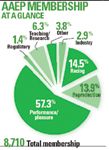AAEP to study CE expansion
Seattle — The American Association of Equine Practitioners (AAEP) is planning to study the viability of regional continuing education.
SEATTLE — The American Association of Equine Practitioners (AAEP) is planning to study the viability of regional continuing education.
"About one-third of our membership worldwide attends our annual convention, but that means about two-thirds do not," says AAEP Executive Director David Foley. "So our new strategic plan calls for us to at least investigate the feasibility of some regional meetings, and if we do that, they probably won't roll out until '07."

AAEP Membership At A Glance
The Board of Directors approved the due diligence during AAEP's 51st-annual conference in December. The convention welcomed more than 5,800, and the tradeshow waiting list was 65 companies deep, three times as many as years past.
Most of the draw for the about 3,000 veterinarians, technicians and veterinary students was the 86 total hours of unique continuing education, says new association President Dr. Thomas Brokken, senior partner and president of Thoroughbred racetrack practice Teigland, Franklin & Brokken.
He says the association must leverage the strength of its annual conference to bring more education to its members.

AAEP Welcomes New Executive Team
"Continuing education has been an emphasis of a half-dozen past presidents, and I worry about it daily because it's very important to me," he says. "We can never let up because we are under heavy competition by all types of people who are putting on continuing education. So we want to put on really high-quality, cutting-edge content."
Some of the new topics rolled out for December's show included an in-depth look into the newest trends in imaging and lameness as digital radiography and magnetic resonance imaging grow more accessible to the average private veterinary practitioner.
Other new topics included lameness in motion, or the depiction of different kinds of lameness as it transpires in the actual motion of an animal, as well as pain management.
"They have found in human medicine that the management of pain in the human being really speeds recovery and healing, and in animals, it's a little more difficult to depict this pain management, but we've done a lot of research on this now, and there is a lot more information."
The association is also taking a closer look at how demographics are changing in equine medicine. Albeit slower than in small animal circles, equine practices are welcoming increasingly more women into the discipline. The gender shift is forcing much of the profession to examine how to make equine medicine more attractive to aspiring animal doctors. They are even handing out quality-of-life tips.
"About 35-36 percent of our members are women, and that's going to change fairly drastically during the next 10 years, so we are trying to give all our members adequate information and leadership on how they can lead their lives and also their professional life, and that's part of our strategic plan."
The scrutiny on quality of life has become crucial as competition cranks up to retain more manpower in large animal disciplines.
"We need more equine veterinarians," Brokken says. "Some schools have about 10-12 people in the discipline, and others have one to two. We need probably about 150 every year."
The association plans to strengthen its student internships, externships and other student programs to encourage them to stay with equine medicine in the last couple years of their schooling, Brokken says.
He'll also lead AAEP into more of an issue-advocacy role in conjunction with the American Veterinary Medical Association, American Horse Council and other organized political and education efforts.
Two formal education programs were launched to broaden understanding of equine health. HORSE FACTS (see story) will illustrate the importance of biomedical research in developing new technologies. America's Healthy Horse, a collaboration between AAEP and Fort Dodge Animal Health, targets owners of the millions of horses that currently are not seen by a veterinarian regularly. "Every horse. Every spring and fall." is the tag line for promoting biannual wellness exams. Currently, a veterinarian sees only about 36 percent of horses at least twice a year.